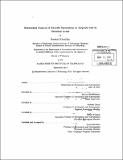Networked control of aircraft operations at airports and in terminal areas
Author(s)
Khadilkar, Harshad (Harshad Dilip)
DownloadFull printable version (17.01Mb)
Other Contributors
Massachusetts Institute of Technology. Department of Aeronautics and Astronautics.
Advisor
Hamsa Balakrishnan.
Terms of use
Metadata
Show full item recordAbstract
The goal of this thesis is to develop a control strategy for airport operations that integrates the management of arrivals and departures. The strategy is based on four central ideas: (1) the objective of reducing aircraft flight times, taxi times and fuel burn, (2) the emphasis on developing models using data from actual aircraft operations, (3) the need to be compatible with current air traffic control procedures, and (4) the requirement to not adversely affect airport performance. The scope of this work covers the airport surface and arrival airspace, which are two of the most congested regions of the air transportation network. A new approach is proposed for modeling airport surface operations. Drawing an analogy from the field of network congestion control, the airport surface is assumed to be a network consisting of major taxiways and their intersections. Posing the problem in this framework relaxes the requirement of precisely predicting the taxi time of each aircraft, instead emphasizing the accurate representation of the underlying stochastic processes. At the same time, it allows one to address the issues of network stability and performance through analytical approaches. Based on this model for surface operations, a control algorithm is developed for regulating the time of entry of aircraft into the network. Simulations show that this strategy can significantly reduce surface congestion and aircraft fuel burn without hampering airport performance. The arrival airspace control algorithm presented in this thesis proposes a hybrid centralized / distributed algorithm for conflict detection and resolution. It combines distributed control in low-density airspace with centralized control in high-density terminal areas. This approach has the advantage of reducing ground infrastructure cost due to decentralization, while still operating at an efficiency level close to that of a fully centralized control strategy. The arrival and departure control algorithms are then combined to formulate an integrated strategy for managing airport operations, significantly improving the separate gains that can be obtained from each component.
Description
Thesis: Ph. D., Massachusetts Institute of Technology, Department of Aeronautics and Astronautics, 2013. Cataloged from PDF version of thesis. Includes bibliographical references (pages 149-157).
Date issued
2013Department
Massachusetts Institute of Technology. Department of Aeronautics and AstronauticsPublisher
Massachusetts Institute of Technology
Keywords
Aeronautics and Astronautics.